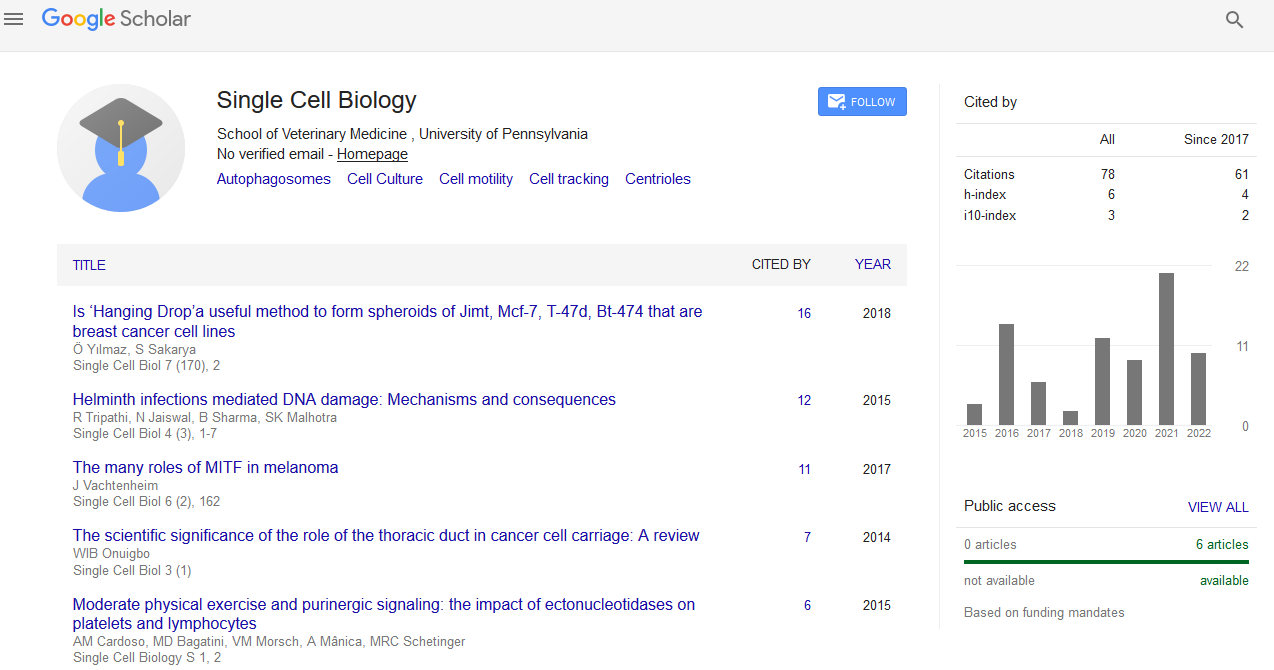PMC/PubMed Indexed Articles
Indexed In
- ResearchBible
- CiteFactor
- RefSeek
- Hamdard University
- EBSCO A-Z
- Publons
- Geneva Foundation for Medical Education and Research
- Euro Pub
- Google Scholar
Useful Links
Share This Page
Journal Flyer

Open Access Journals
- Agri and Aquaculture
- Biochemistry
- Bioinformatics & Systems Biology
- Business & Management
- Chemistry
- Clinical Sciences
- Engineering
- Food & Nutrition
- General Science
- Genetics & Molecular Biology
- Immunology & Microbiology
- Medical Sciences
- Neuroscience & Psychology
- Nursing & Health Care
- Pharmaceutical Sciences
Commentary - (2022) Volume 11, Issue 1
Modification and Biomedical Applications of Novel Materials
Sergey Dorozhkin*Received: 04-Jan-2022, Manuscript No. SCPM-22-12; Editor assigned: 06-Jan-2022, Pre QC No. SCPM-22-12; Reviewed: 20-Jan-2022, QC No. SCPM-22-12; Revised: 25-Jan-2022, Manuscript No. SCPM-22-12; Published: 31-Jan-2022, DOI: 10.35248/2168-9431.22.11.012
About the Study
There are many types of materials for different purposes. In this context, biomaterials are characterized by their ability to remain in contact with the tissues of the human body. Biomaterials an exciting field that has grown significantly and steadily over the last 50 years, covering aspects of medicine, biology, chemistry and materials science.
Biomaterials have been used in a variety of applications such as joint replacement, bone plates, bone cement, artificial ligaments and tendons, dental implants for tooth fixation, vascular prostheses, heart valves, artificial tissues, contact lenses and breast implants. In the future, biomaterials are expected to promote the regeneration of natural tissues, thereby promoting the recovery of structural, functional, metabolic and biochemical behavior and biomechanical performance. As the number of people in need of implants grows, the design of new, low-cost, biocompatible materials is important for improving the living conditions and well- being of the population.
In this sense, the process used to manufacture biomaterials should be affordable, fast and easy to carry out. Several methods have been used to create new bioactive, biocompatible materials with osteoconductivity and indelibility. New biomaterials have been introduced since 1971. An example is Bioglass 45S5, which can bind to bone by forming a surface layer of hydroxyapatite. The Zolgel process is currently used to produce bioactive coatings, powders and substrates that can be used as implants and sensors by molecularly controlling protein and cell uptake and biological behavior. In particular, there are several studies in the literature on the use of solely processes to produce biomaterials such as Nano biologically active glass, porous bioactive glass, and bioactive glass. Hybrid inorganic-organic nanocomposites first appeared about 20 years ago.
The sol-gel process is a technique whose conditions have proven to be suitable for the preparation of these materials, producing nanoscale combinations of inorganic and organic composites. Natural bone is an inorganic-organic composite material composed primarily of nano hydroxyapatite and collagen fibers. The hybrid material obtained by the sol-gel method combines the advantages of organic and inorganic properties. Several types of organic functional alkoxysilanes precursors have been investigated for the production of silica nanoparticles. Sol-gel offers advantages such as the ability to obtain homogeneous hybrid materials at low temperatures, allowing the incorporation of a wide variety of compounds.
The sol-gel process is based on the hydrolysis and condensation of metals or silicon alkoxides and is used to obtain a variety of easy-to-manufacture, high-purity inorganic oxide or hybrid inorganic organic materials. This method can be used to synthesize functionalized silica with controlled particle size and shape. Apart from the various applications mentioned in the first section of this chapter, biomaterials have recently been used as drug delivery systems.
In this sense, polymers and biodegradable polymers are potential materials because they promote timely and targeted drug release. In fact, biomaterials have a profound effect on human health. Applications include medical devices, diagnostics, sensors, and tissue engineering in addition to the DDS mentioned above. In the latter region, ideal drug delivery agents target biologically active molecules at the desired rate and duration to maintain drug levels in the body at optimal therapeutic concentrations with minimal variability.
Citation: Dorozhkin S (2022) Modification and Biomedical Applications of Novel Materials. Single Cell Biol. 11: 012.
Copyright: © 2022 Dorozhkin S. This is an open access article distributed under the terms of the Creative Commons Attribution License, which permits unrestricted use, distribution, and reproduction in any medium, provided the original author and source are credited.

